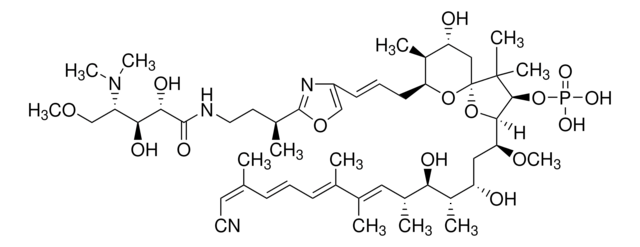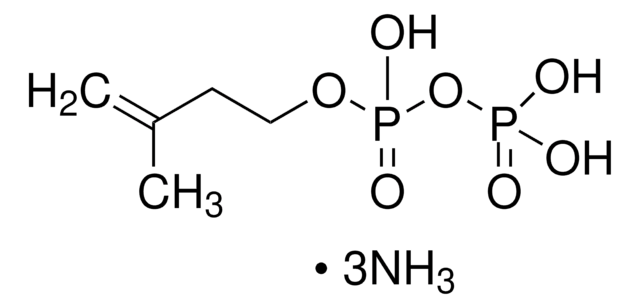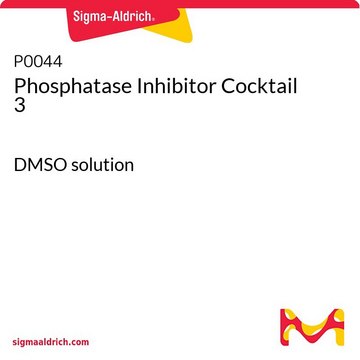208851
Calyculin A
from Discodermia calyx, ≥98% (HPLC), crystalline (powder), protein phosphatases types 1 and 2A inhibitor, Calbiochem
Synonim(y):
Calyculin A, Discodermia calyx
About This Item
Polecane produkty
Nazwa produktu
Calyculin A, Discodermia calyx, Calyculin A, CAS 101932-71-2, is a cell-permeable inhibitor of protein phosphatase 2A (IC₅₀ = 0.5-1 nM) and protein phosphatase 1 (PP1; IC₅₀ = 2 nM).
Poziom jakości
Próba
≥98% (HPLC)
Formularz
crystalline (powder)
producent / nazwa handlowa
Calbiochem®
warunki przechowywania
OK to freeze
desiccated (hygroscopic)
protect from light
kolor
white
rozpuszczalność
ethanol: 2 mg/mL
DMSO: soluble
Warunki transportu
ambient
temp. przechowywania
−20°C
ciąg SMILES
[P](=O)(O[C@H]1[C@H](O[C@]2(O[C@@H]([C@@H]([C@H](C2)O)C)C\C=C\c3nc([o]c3)[C@H](CCNC(=O)[C@@H](O)[C@@H](O)[C@@H](N(C)C)COC)C)C1(C)C)[C@@H](OC)C[C@H](O)[C@H]([C@H](O)[C@H](C)\C=C(/C)\C(=C\C=C\C(=C/C#N)\C)\C)C)(O)O
InChI
1S/C50H81N4O15P/c1-29(20-22-51)16-14-17-30(2)32(4)24-33(5)42(57)35(7)38(55)25-41(65-13)45-46(69-70(61,62)63)49(8,9)50(68-45)26-39(56)34(6)40(67-50)19-15-18-36-27-66-48(53-36)31(3)21-23-52-47(60)44(59)43(58)37(28-64-12)54(10)11/h14-18,20,24,27,31,33-35,37-46,55-59H,19,21,23,25-26,28H2,1-13H3,(H,52,60)(H2,61,62,63)/b16-14+,18-15+,29-20-,30-17+,32-24+/t31-,33+,34+,35+,37-,38-,39-,40+,41-,42+,43-,44-,45+,46-,50-/m0/s1
Klucz InChI
FKAWLXNLHHIHLA-QJLNTFFJSA-N
Opis ogólny
Działania biochem./fizjol.
PP2A
Opakowanie
Ostrzeżenie
Rekonstytucja
Inne uwagi
Takeuchi, T., et al. 1994. Biochem. Biophys. Res. Commun. 205, 1803.
Figurov, A., et al. 1993. Eur. J. Neurosci. 5,1083.
Song, Q., and Lavin, M.F. 1993. Biochem. Biophys. Res. Commun.190, 47.
Gopalakrishna, R., et al. 1992. Biochem. Biophys. Res. Commun.189, 950.
Carl, A., et al. 1991. Am. J. Physiol.261, C387.
Suganuma, M., et al. 1990. Cancer Res.50, 3521.
Cohen, P. 1989. Annu. Rev. Biochem. 58, 453.
Cohen, P., et al. 1989. J. Biol. Chem.264, 21435.
Ishihara, H., et al. 1989. Biochem. Biophys. Res. Commun.159, 871.
Kato, Y., et al. 1988. J. Org. Chem.53, 3930.
Kato, Y., et al. 1986. J. Am. Chem. Soc.108, 2780.
Informacje prawne
Hasło ostrzegawcze
Danger
Zwroty wskazujące rodzaj zagrożenia
Zwroty wskazujące środki ostrożności
Klasyfikacja zagrożeń
Acute Tox. 3 Dermal - Acute Tox. 3 Inhalation - Acute Tox. 3 Oral - Skin Irrit. 2
Kod klasy składowania
6.1C - Combustible acute toxic Cat.3 / toxic compounds or compounds which causing chronic effects
Klasa zagrożenia wodnego (WGK)
WGK 3
Temperatura zapłonu (°F)
Not applicable
Temperatura zapłonu (°C)
Not applicable
Certyfikaty analizy (CoA)
Poszukaj Certyfikaty analizy (CoA), wpisując numer partii/serii produktów. Numery serii i partii można znaleźć na etykiecie produktu po słowach „seria” lub „partia”.
Masz już ten produkt?
Dokumenty związane z niedawno zakupionymi produktami zostały zamieszczone w Bibliotece dokumentów.
Nasz zespół naukowców ma doświadczenie we wszystkich obszarach badań, w tym w naukach przyrodniczych, materiałoznawstwie, syntezie chemicznej, chromatografii, analityce i wielu innych dziedzinach.
Skontaktuj się z zespołem ds. pomocy technicznej






